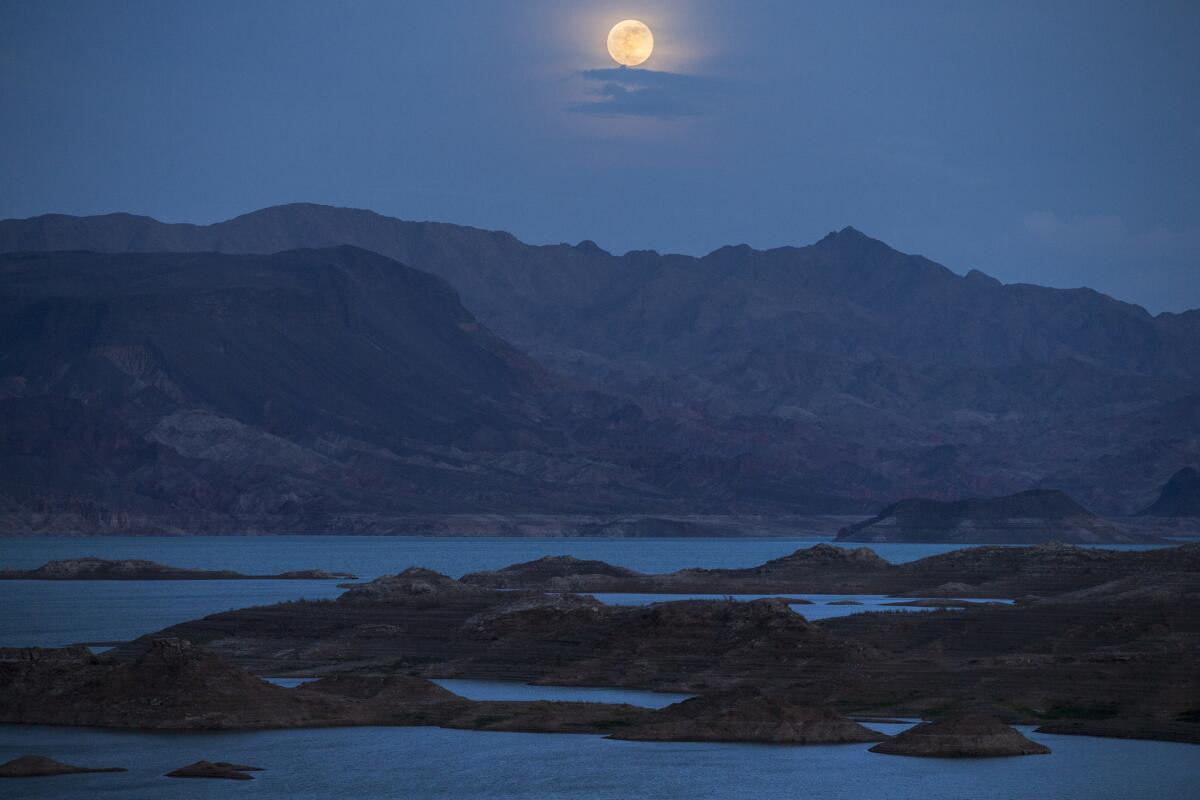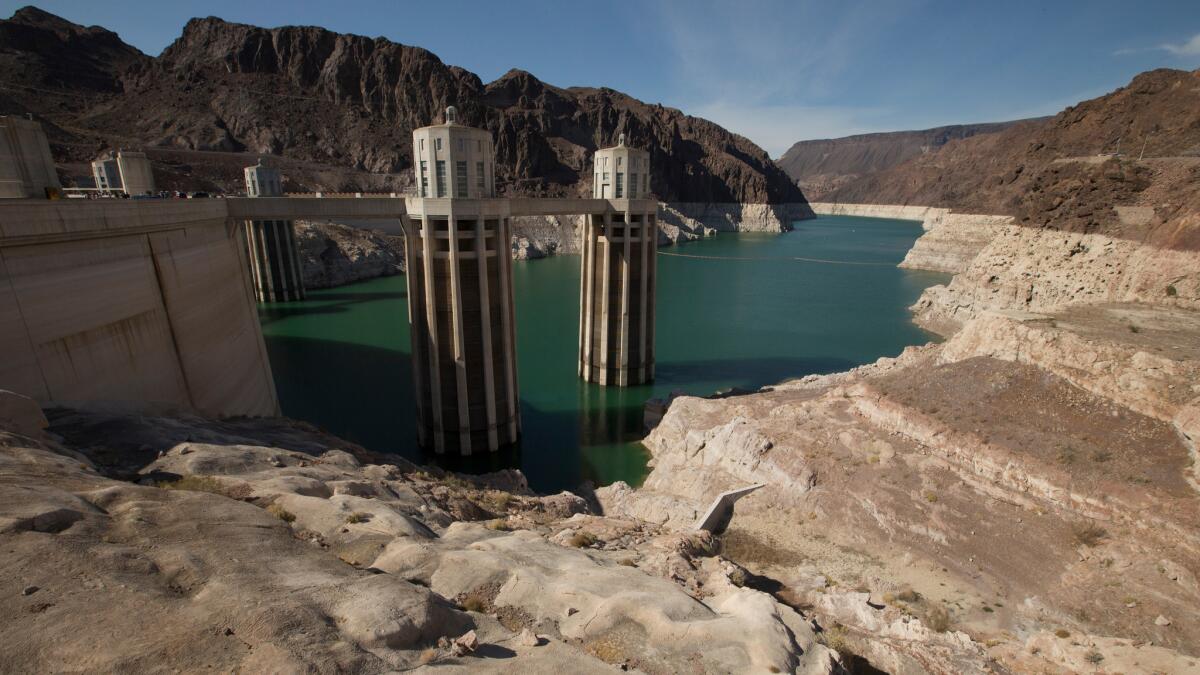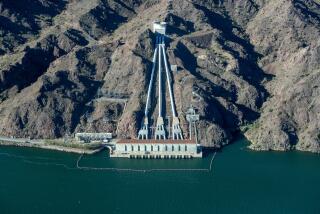The forecast for Lake Mead: Hot and dry with plenty of anxiety

A reckoning arrives every August for the Colorado River and the 40 million people across the West who depend on it.
After water managers measure annual inflows and outflows and do their best to estimate future precipitation in places as far-flung as northwestern Wyoming and southwestern New Mexico, they make a pronouncement that once was arcane but has become increasingly prominent — and ominous.
Technically, what they announce is the projected elevation of Lake Mead, the Colorado River’s largest reservoir, on Jan. 1 for each of the next two years.
Psychologically, in a region already parched by years of drought and staring into a hotter, drier, climate-changed future, they are forecasting anxiety.

Under current policy, if the projected elevation falls below 1,075 feet on Jan. 1, states in the southern part of the basin face a “shortage.” That would prompt mandatory cuts in water use that could force farmers to fallow fields and require cities and tribes to reduce use.
In the eight decades since the Hoover Dam was completed and Lake Mead was first filled, that has never happened.
Then, last month, it did.
For a while. Sort of. Maybe.
On Aug. 16, the Bureau of Reclamation, the federal agency that oversees the basin, projected that Lake Mead would fall below the 1,075 threshhold — not next year, but in 2018. It released a report predicting it would reach the 2018 shortage by a narrow margin — the lake would fall to 1.074.31 feet on Dec. 31, 2017 — but it would be a shortage nonetheless.
Yet the following week, another bureau report came out that shed more light on that forecast. Instead of just projecting an elevation level, it stated the specific probability that the lake would hit that level. The chance, the agency said, was 48%.
Or, as Rose Davis, a spokeswoman for the Lower Colorado region of the bureau, put it: “It’s kind of a flip of the coin.”
So, by that math, maybe there will be a shortage in 2018 and maybe there will not be. Maybe the Southwest will finally confront the very real limits of its water supply. Or maybe it will not.
Except the story does not end there.

The Bureau of Reclamation’s projection does not take into account some major conservation measures that states in the lower part of the river basin are undertaking — measures that water managers say have already helped avoid a shortage in 2017.
In Arizona alone, water officials say that, by next summer, their conservation work could be effective enough to lift the projected elevation of Lake Mead for 2018 by more than 2 feet, enough to fend off a shortage for another year.
And then there is the “drought contingency plan,” which is being developed by Mexico, Arizona, Nevada, California and the Bureau of Reclamation to voluntarily reduce water use even further — before a shortage could be declared for 2018, but also in the event one is declared after that. The plan, which would need legislative approval in Arizona and the support of water managers in other states, could be in place by early 2017.
State and local water managers say they are working together so that, well, they can keep working together. If they do not, they fear, the federal government will intervene and they will lose control.
“This is our opportunity, collectively, to manage our future together rather than outsourcing it to the secretary of the interior,” said Chuck Cullom, the manager of Colorado River programs for the Central Arizona Project, which provides water to metropolitan Phoenix and other parts of the state.
Of course, that future together looks pretty forbidding no matter who is managing it.
While forecasting the level of Lake Mead might seem like fuzzy math, the general arc of things is not in dispute. The same report that showed a 48% chance of a shortage in 2018 shows the chance of shortage at 60% in 2019, 60% in 2020 and 56% in 2021.
Few water managers hold out great hope that the snowpack, the single most important source of precipitation for the basin, will suddenly rise dramatically, year over year. Experts have established that there is a structural deficit on the river — more demand than supply. Most people close to the process think the region will slowly, sometimes painfully, shift water resources away from certain kinds of agriculture, which uses the vast majority of the supply, and toward urban populations.
So when you look at it that way, the fuzzy math at Lake Mead is not really fuzzy at all.
“Basically, what the models say is that, in the future, most years will be shortage years,” said Bill Hasencamp, the manager of Colorado River resources for the Metropolitan Water District of Southern California. “Shortages are going to be a way of life.”
Twitter: @yardleyLAT
ALSO
ITT Tech shuts down all its schools; one student says he’s ‘angry times 10 million’
Hanjin Shipping’s parent to raise and spend $90 million to unload stranded cargo ships
The Times has updated its Electoral College map: What’s new?
More to Read
Start your day right
Sign up for Essential California for news, features and recommendations from the L.A. Times and beyond in your inbox six days a week.
You may occasionally receive promotional content from the Los Angeles Times.







